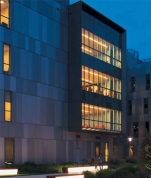ISE Lab: the Principles of BIM Technology

Opened in the fall of 2013, the University of Delaware’s Interdisciplinary Science and Engineering Laboratory (ISE-Lab) was designed around the philosophy of integrating teaching, learning and research. This 194,000-squarefoot facility is intended to engage students and stimulate excitement about science and engineering for a new generation. The ISE-Lab includes classrooms and teaching laboratories, as well as state-of-the art imaging and synthesis laboratories and a class 100/1000 clean room. Also included are spaces for open collaboration for teams of researchers and offices for University institutes related to energy and the environment.
The University challenged the design and construction team to rethink how the traditional materials of campus Georgian architecture could be incorporated in an entirely new design style. The team embraced this challenge as an opportunity to rethink the building’s design style, but also to deliver a modern building that could only be realized through modern project delivery techniques.
The resultant process affected everything from the selection of consultants, to collaboration with the Construction Manager, to how design ideas were presented to the client. The architect and consulting engineers developed thirteen design models using Revit, which were combined to allow a full understanding of how each building system affected the other.
These models were constantly available to the CM team and fabricators via the project cloud, and were used for takeoffs, coordination, scheduling, and site layouts. The free and open sharing of design models with the CM and fabricators fostered a sense of trust among the stakeholders, as well as fully leveraging design intent models and datasets.
This greatly improved understanding of the building design and enhanced communication between team members. The success of every major construction project hinges on clear expectations and communication, a level of trust between all team members and a willingness to openly share data. Building Information Modeling (BIM) was a critical component in integrating the entire project team and allowed a greater level of analysis and coordination, as well as understanding of the site and building systems.
Full content of this issue you can read here
The full version of the article can be read in our printed issue, also you can subscribe to the web-version of the magazine
 Materials provided by The American Institute of Architects
Materials provided by The American Institute of Architects


